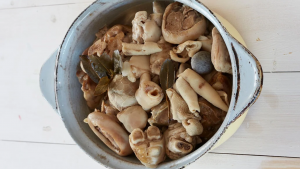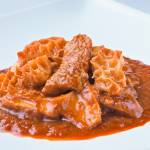There are many ingredients that have a name that instantly makes your stomach churn. Among those are ‘Afval’ and although it may sound awful, this culinary delicacy not only tantalises the taste buds but also reflect a profound connection with sustainability.
What is Afval?
Afval, pronounced as “uh-fahl,” is a dish originating from South Africa, particularly among the Afrikaans-speaking community. The term “Afval” translates to “offal” in English, referring to the less commonly used parts of an animal, such as the liver, heart, lungs, and intestines. These parts are often overlooked in modern cuisine but were historically utilised due to their abundance and the necessity to minimise food waste.
Where did it all start?
The history of Afval dates back to the early settlers in South Africa, who utilised every part of the animals they raised for sustenance. The concept of utilising afval reflects a practical approach to cooking and eating, where nothing goes to waste. Over time, afval became a cultural and culinary tradition, passed down through generations as a symbol of resourcefulness and culinary heritage.
Read more: A tripe affair
Benefits of Afval
Sustainability: Afval highlights the importance of sustainable eating practices. By using often discarded parts of the animal, this dish promotes a reduction in food waste, aligning with modern concerns about environmental impact.
Nutritional Value: Offal is nutrient-rich, containing vitamins, minerals, and proteins that contribute to a balanced diet. Incorporating these elements into afval adds nutritional depth to the meal.
Flavour and creativity: Afval presents an opportunity for culinary creativity. When prepared thoughtfully, these less conventional ingredients offer unique textures and flavours that can surprise and delight the palate.
Cultural heritage: Afval is more than just a dish; it’s a cultural bridge to South Africa’s history. Preparing and enjoying Afval is a way to connect with the past and honour culinary traditions.
As culinary practices evolve, so does the preparation of Afval. Chefs around the world are experimenting with traditional recipes, infusing modern techniques and flavours to create innovative dishes that pay homage to the original concept. Many cooks prefer to use tripe as their ‘afval’ meat. Tripe is the stomach lining of various ruminants.
Try this delicious Ox Tripe recipe
Ingredients
- 1,5 kg Ox tripe
- 3 litres Water
- 1 Onion, finely chopped
- 2 Tbsp Seven Colours Grill Seasoning
- 2 Tbsp Curry powder
- 1 Tbsp Paprika
- 500 ml warm Beef stock
Instructions
In a large pot, boil the tripe in the water for 3 hours.
Add the onion, Seven Colours Grill Seasoning, curry powder and paprika.
Pour in the beef stock and cook until the sauce has reduced and thickened.
Notes
TIP: Serve with samp and beans or pap.
ALSO SEE: Health benefits of eating tripe
Written by Maegan-Leigh Jacobs
Recipe by: Chef Thilivhali Mash Mugwena
Feature image: Pixabay











